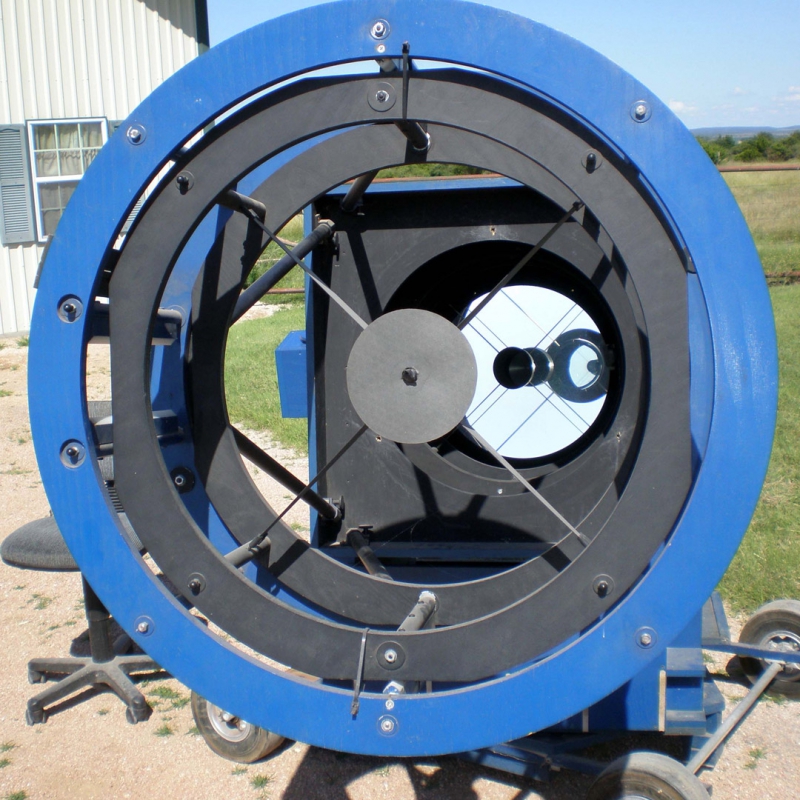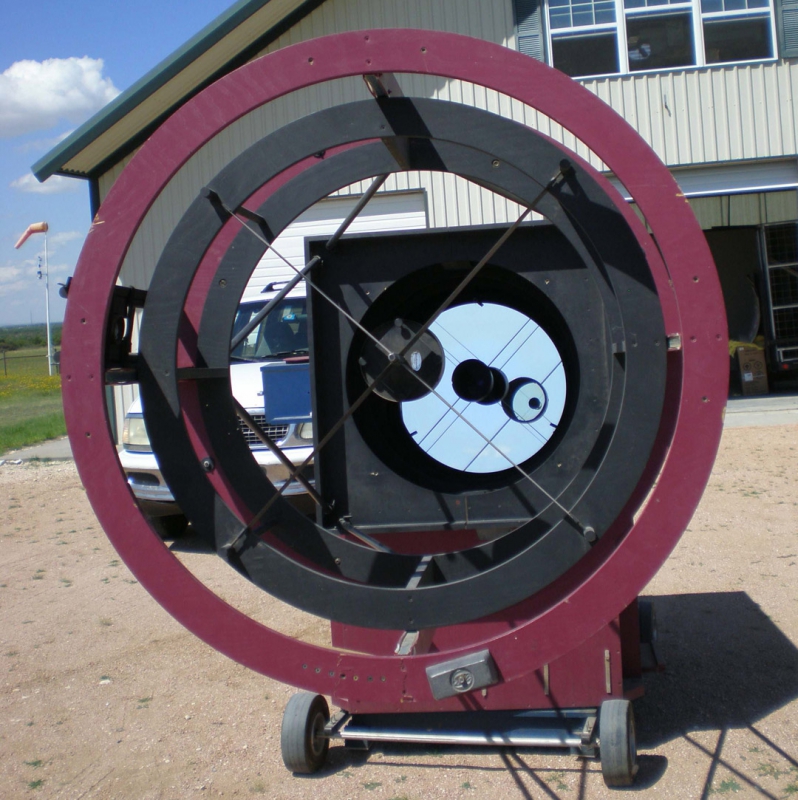Clyde Bone and His Two Unusual Mersenne Telescopes!
In this guest blog post, Ted Hume describes two telescopes designed and built by Clyde Bone. At first they appear to be “big-Dobs.” However, look close and you’ll note they don’t require “shaky ladders” as the final focus is through Tele Vue telescopes near ground-level. They also serve as their own finders. Read on about these fascinating instruments and how they could be yours!

Clyde M. Bone, Jr. (1928 − 2012) of San Angelo, Texas designed and built two Mersenne telescopes, first a 20-inch and then a 30-inch.
His career included working for the Texas Border Commission in the Big Bend area of Texas, geologist for an oil company ─ who flew a light plane to drilling sites and landed on dirt roads, science teacher at a Texas high school and in the Texas prison system. When he decided to build a Mersenne telescope, he was retired and spent a year studying optics. Then he was ready.
Clyde completed his 20-inch Mersenne in 1993-4. It uses a Tele Vue Genesis (4-inch, f/5) refractor along with a 12mm Tele Vue Nagler Type 2 eyepiece as its “eyepiece.” The primary mirror is f/5 and made of Pyrex. Al Nagler convinced Clyde bring it up north to the Stellafane star party in 1994 where he won the “mechanical design” award for the telescope.
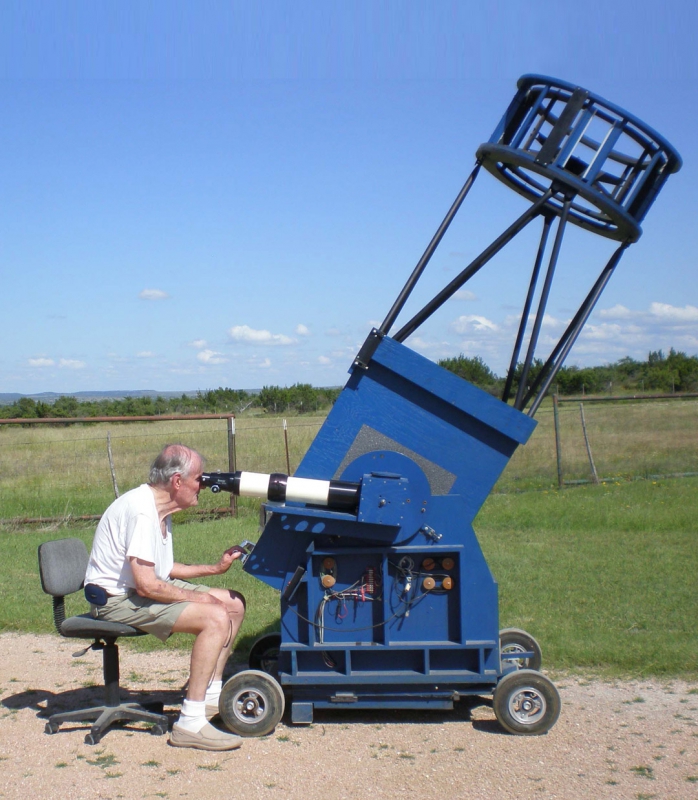
- Light is gathered by a large parabolic primary mirror (1) at the bottom of the instrument that produces a cone of light back toward the top, as in a Newtonian reflector.
- A convex paraboloid secondary mirror of equal focal ratio to the primary (2) is square in the tube toward the top. The focal points of both these mirrors coincide (confocal). This causes the light cones to “cancel” coming off the secondary and become a cylinder (parallel rays) of light.
- These parallel rays travels toward the primary mirror but are intercepted by a diagonal flat mirror in front of the primary (3). That reflects the light at a right-angle out the altitude axis of the mount.
A final flat mirror outside the tube (4) again reflects the light at a right-angle parallel with the ground. This feature enables viewing from a sitting position, no matter how high the scope is aimed. This is often referred to as a Mersenne-Nasmyth design. - Finally, the light passes through a flat-field, 4-element, f/5 refractor (5) that “sees” the parallel rays as light coming from infinity ─ just like it would as if were looking directly at the sky ─ and an eyepiece is used to magnify the refractor’s image (6).
Because the light rays are parallel entering the refractor, the final focal ratio is the same as the refractor − f/5 in this case.
So what’s it like
looking through one
of these scopes?
“Actually pretty
normal until you
start panning.
Then it’s magic.”
– David Nagler
Another feature is that at low-power, the refractor “sees” off-axis light (brown lines in the diagram) passing around the secondary, bouncing through the flats, and into the refractor objective without encountering the primary or secondary mirror. This “peripheral” light is essentially what the refractor would “see” if it were aimed at the sky alone. The result is a highly magnified target in the center of a low-power field! The system acts as its own finder! David Nagler describes the overlay of the low- and high-power fields as blending together almost unnoticeably — until you move the scope while observing. Then the effect is “mind-blowing.” Panning the scope you see objects slowly moving at the edge of the field and then suddenly transition to a fast-moving “aperture explosion” in the high-power center field.
Next, he longed for a 30-inch Mersenne telescope, but there was no refractor available with an appropriate aperture and short enough focal length to prevent the Mersenne from being too long to handle comfortably. Clyde told me that for a year or more he tried to talk Al Nagler at Tele Vue into making such a refractor. Finally Al agreed to make a 140mm, f/5 refractor (Tele Vue-140). However, after making less than 40 of these, Al ceased production, saying that it was too difficult a process to make. This refractor has since become a legendary and highly collectible Tele Vue item, both for its outstanding optics and its portability.
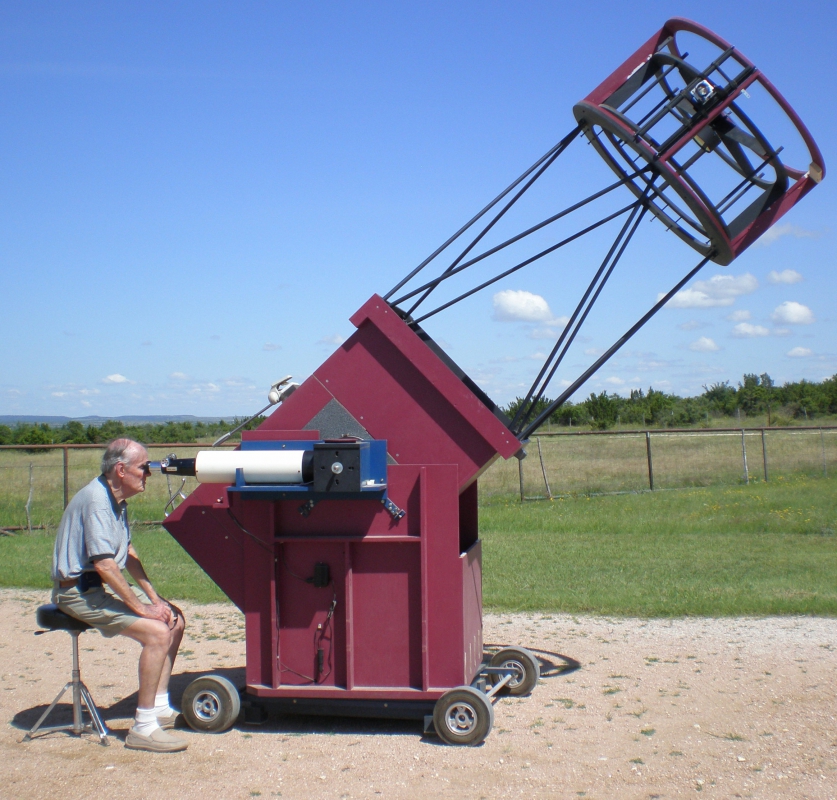
For the 30-inch Mersenne Clyde ordered an astro Sitall (glass-ceramic) primary mirror blank from Russia, waited 4 months, and when he opened the box it was broken. So he ordered another, waited 4 months, and it arrived in good condition. It was figured and coated by an optical specialty company.
Clyde could not find a company that would make the convex f/5 secondary mirrors for the two scopes. So he built a grinding machine and monochromatic lightbox and made them himself, which required almost 2 years. Upon finally finishing this task, he decided that he should have a backup 6” secondary, so he made another. I have it safely stored.
This scope was finished in 1998 and was a popular item at the week-long Texas Star Party (TSP) for several years. Clyde partially dismantled the scope for travel to TSP where he spent a day reassembling and collimating it. He said that this was time well spent for 7 days of observing at a very dark site.

His favorite deep-sky object was M17, the “Swan Nebula”, or “Omega Nebula”, in Sagittarius. One night when the seeing was excellent, he gazed at the Swan and exclaimed, “I can see feathers!” As I recall, Al, David, and I had a good laugh.
One last TSP anecdote: Al Nagler was kind several times to let us borrow a Tele Vue Bino Vue. Clyde lost almost all of his sight in one eye in an oilfield accident when he was quite young. But, his one good eye was very good. One evening we walked out onto the observing field at TSP he looked up and said, “M13 looks good tonight.” My reply was, “you can’t see M13 naked eye.” He replied, “damned sure can. Take a good look. Use averted vision.” He was right. Thus I learned yet another of many things about astronomy from this interesting man.

Clyde was a master craftsman. The design and construction of his two Mersennes is a pleasure to behold. Both are Dobsonian mounted with rocker boxes made of the finest Baltic plywood. His attention to detail is outstanding.
Clyde described his Mersenne scopes as “combining the light-gathering ability of a large aperture reflector with the image-making properties of a high quality refractor” – the best of both worlds. He was also fond of informing people that the confocal mirrors eliminated the aberrations of a Newtonian reflector thus complementing the highly corrected flat-fields of the Tele Vue refractors.
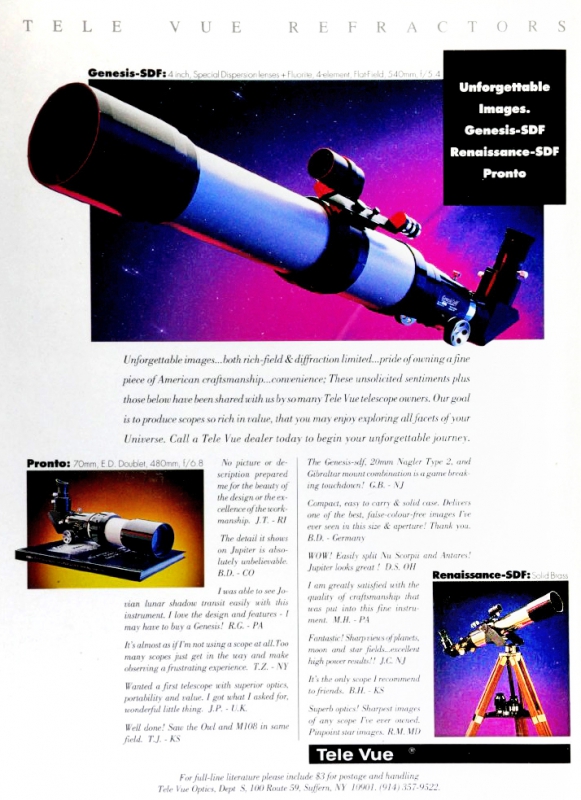
Soon after he finished the 30” scope we moved it and the 20” scope from his garage to the observatory site of the San Angelo Astronomy Association (SAAA), about six miles away from city lights, where we had built a storage building for the two scopes. After about a year, we decided that the 30-inch scope deserved its own real observatory building. We already had poured a 16 foot octagonal slab onto which we rolled the scope for viewing. Clyde and I designed and built a rotating octagonal building on this slab, complete with roof shutters. It took us a year. The big scope lived and operated well there for a few years. Then the two of our Fellow SAAA members who owned the 90 acre plot of land decided to sell it. So the SAAA had to abandon its nice concrete observing slabs and 4 buildings (one with a roll-off roof that housed a 12-inch reflector). We were lucky to obtain permission from a friend to let us build a storage building on his ranch 9 miles south of the city.
20-inch Mersenne Telescope Specifications (For Sale)
- Primary mirror: 20-inch diameter f/5 Pyrex concave paraboloid
- Secondary mirror: 4-inch, f/5 Pyrex convex confocal paraboloid
- Tertiary and Quaternary mirrors: 4-inch Pyrex diagonal flats.
- All mirrors are 1/10 wave or better
- Refractor “Eyepiece”: Tele Vue Genesis 101mm, f/5 apochromatic refractor with a 12mm Tele Vue Nagler Type 2 ocular
- Mount: Dobsonian with truss tubes.
- Ground board: has 4 go-cart wheels with pneumatic tires for ease of movement.
- Finder: Sky Commander digital setting circles and Telrad.
- Dob Driver: go-to and tracking (needs tuning to remove occasional azimuth slipping).
- Price: $9,500.00
- Primary mirror: 30-inch diameter f/5 Russian astro Sitall concave paraboloid, 1/16 wave, 96% reflective coating, 27-point support. No fans; this mirror does not need them.
- Secondary mirror: 6-inch, f/5 astro Sitall convex confocal paraboloid, 1/10 wave, 96% reflective coating. Secondary cage is an adjustable “cage within a cage” to properly position the secondary mirror’s focal point.
- Tertiary and Quaternary mirrors: 6-inch Pyrex flats, 98.5% dielectric reflective coating.
- Refractor “Eyepiece”: Tele Vue-140 (140mm, f/5) apochromatic refractor serves as the eyepiece with a 16mm Tele Vue Nagler Type 2 ocular. Other oculars can be used, but the scope likes the 16mm best. It provides 238x magnification and is perfect for most deep sky objects.
- Mount: Dobsonian with truss tubes. Ground board has 4 go─cart wheels with pneumatic tires for ease of movement.
- Finder: Sky Commander digital setting circles and Telrad.
- Tracking: Manual. A finder/tracker system could be added.
- Flexibility: Secondary cage has a Crayford 2” focuser mounted. Scope can easily be converted to a 30-inch f/5 Newtonian. Simply replace the 6-inch convex secondary mirror with the 6-inch diagonal flat that is in front of the primary mirror.
- Clyde’s Telescope in S&T: For further reading, Clyde Bone published an article in the September 1999 issue of Sky & Telescope about his Mersenne scopes. He described this type of scope as a Mersenne primary system, combined with a quality refractor, in a Dobsonian mount. He points out that the optical train allowed him to view through a large telescope from a seated position without need for climbing a “rickety ladder.” “Quality is key,” said Clyde. “If the refractor is not up to the optical standards of the rest of the instrument, the performance of the resulting system will be limited.”
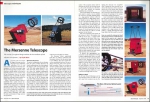
- Information about Tele Vue telescopes on our website (mobile site).



